Deliveroo: Management Style, Structure, and Leadership Analysis
VerifiedAdded on 2022/12/26
|12
|3814
|90
Report
AI Summary
This report offers a detailed analysis of Deliveroo's organisational theory and practice. It identifies the management functions, principles, and styles employed by the CEO, focusing on the democratic style. The report examines the steps taken to implement organisational structure, highlighting the matrix structure, and the influence of Handy's model of organisational culture, particularly the task-oriented culture. Furthermore, it describes various leadership styles, with an emphasis on participative leadership to enhance organisational effectiveness. The report also determines the effects of influence, power, and conflict within Deliveroo, emphasizing expert power and collaborative strategies for conflict resolution. Different types of motivation are explored. The report concludes with recommendations to maximize performance, supported by examples and literature, providing a comprehensive overview of Deliveroo's organisational dynamics. The analysis covers how Deliveroo adapts to challenges, such as those posed by the pandemic, and the impact on the workforce.
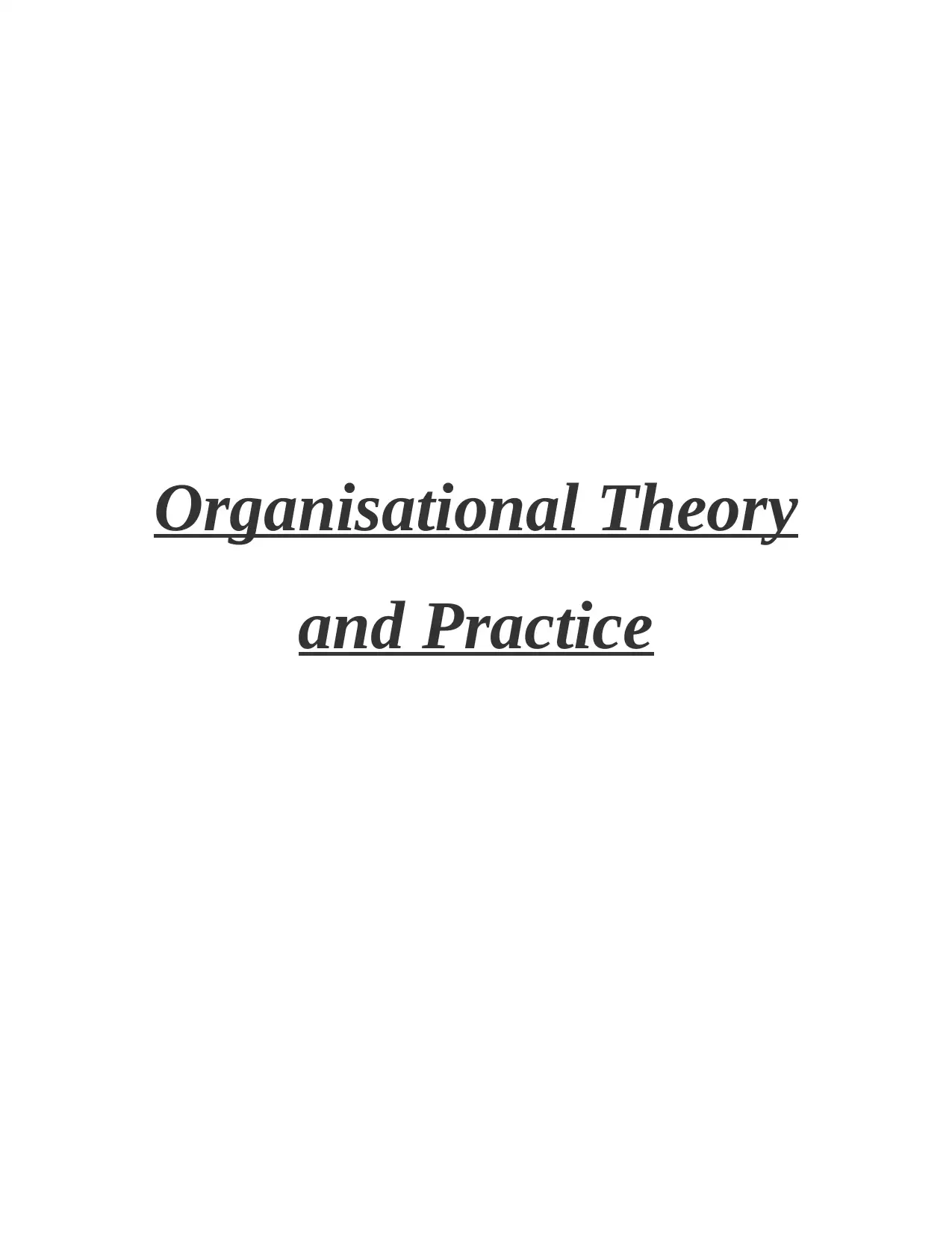
Organisational Theory
and Practice
and Practice
Paraphrase This Document
Need a fresh take? Get an instant paraphrase of this document with our AI Paraphraser
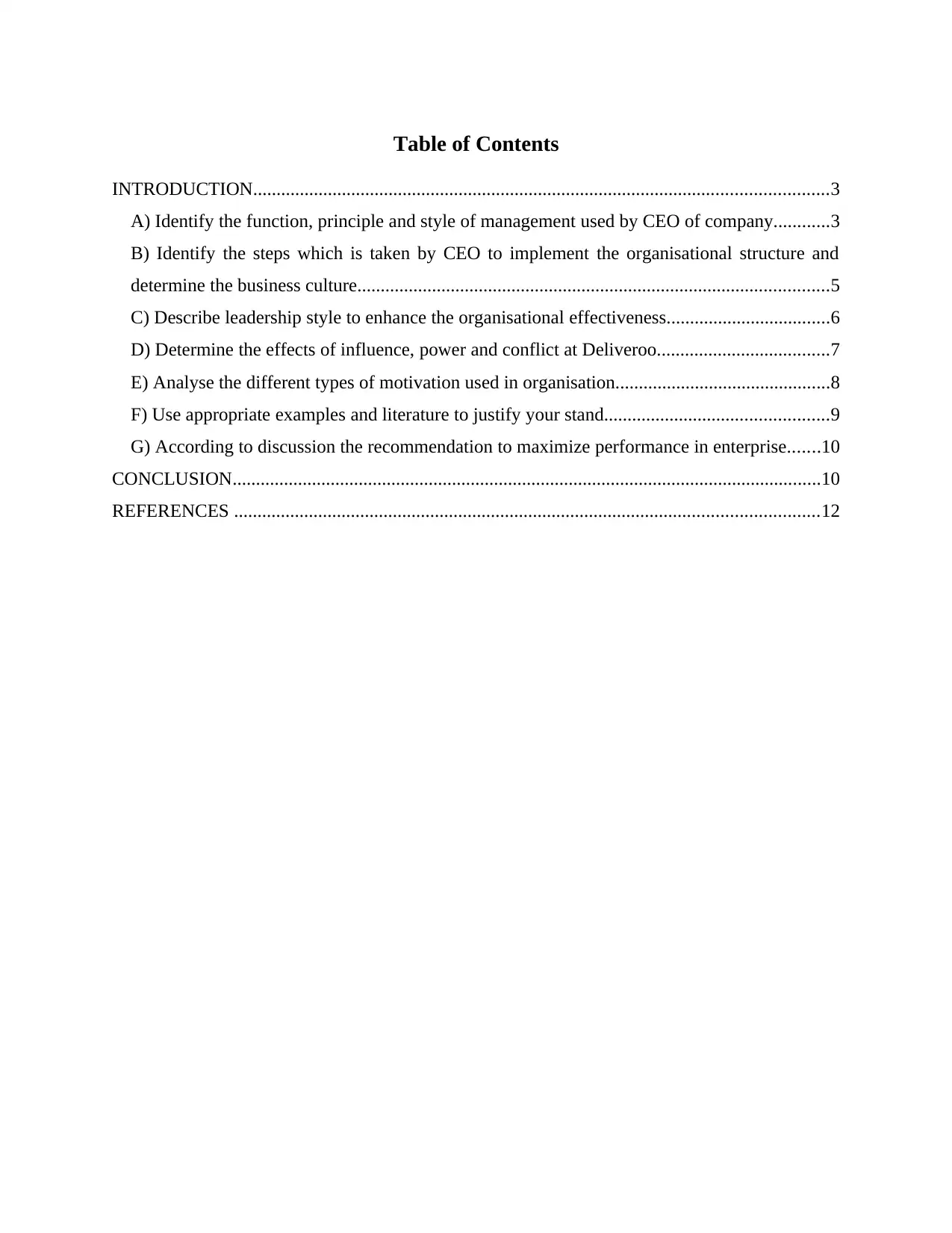
Table of Contents
INTRODUCTION...........................................................................................................................3
A) Identify the function, principle and style of management used by CEO of company............3
B) Identify the steps which is taken by CEO to implement the organisational structure and
determine the business culture.....................................................................................................5
C) Describe leadership style to enhance the organisational effectiveness...................................6
D) Determine the effects of influence, power and conflict at Deliveroo.....................................7
E) Analyse the different types of motivation used in organisation..............................................8
F) Use appropriate examples and literature to justify your stand................................................9
G) According to discussion the recommendation to maximize performance in enterprise.......10
CONCLUSION..............................................................................................................................10
REFERENCES .............................................................................................................................12
INTRODUCTION...........................................................................................................................3
A) Identify the function, principle and style of management used by CEO of company............3
B) Identify the steps which is taken by CEO to implement the organisational structure and
determine the business culture.....................................................................................................5
C) Describe leadership style to enhance the organisational effectiveness...................................6
D) Determine the effects of influence, power and conflict at Deliveroo.....................................7
E) Analyse the different types of motivation used in organisation..............................................8
F) Use appropriate examples and literature to justify your stand................................................9
G) According to discussion the recommendation to maximize performance in enterprise.......10
CONCLUSION..............................................................................................................................10
REFERENCES .............................................................................................................................12
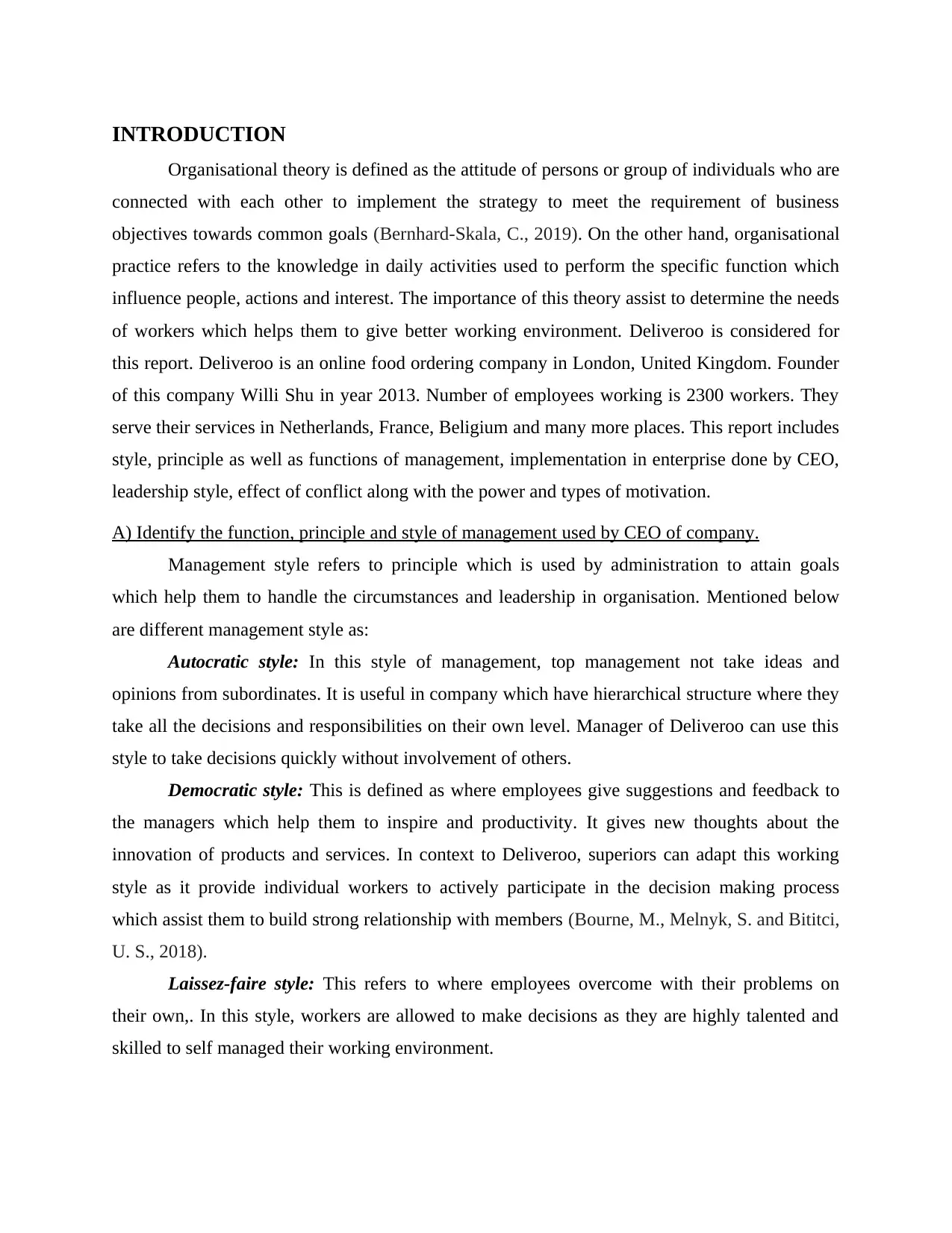
INTRODUCTION
Organisational theory is defined as the attitude of persons or group of individuals who are
connected with each other to implement the strategy to meet the requirement of business
objectives towards common goals (Bernhard-Skala, C., 2019). On the other hand, organisational
practice refers to the knowledge in daily activities used to perform the specific function which
influence people, actions and interest. The importance of this theory assist to determine the needs
of workers which helps them to give better working environment. Deliveroo is considered for
this report. Deliveroo is an online food ordering company in London, United Kingdom. Founder
of this company Willi Shu in year 2013. Number of employees working is 2300 workers. They
serve their services in Netherlands, France, Beligium and many more places. This report includes
style, principle as well as functions of management, implementation in enterprise done by CEO,
leadership style, effect of conflict along with the power and types of motivation.
A) Identify the function, principle and style of management used by CEO of company.
Management style refers to principle which is used by administration to attain goals
which help them to handle the circumstances and leadership in organisation. Mentioned below
are different management style as:
Autocratic style: In this style of management, top management not take ideas and
opinions from subordinates. It is useful in company which have hierarchical structure where they
take all the decisions and responsibilities on their own level. Manager of Deliveroo can use this
style to take decisions quickly without involvement of others.
Democratic style: This is defined as where employees give suggestions and feedback to
the managers which help them to inspire and productivity. It gives new thoughts about the
innovation of products and services. In context to Deliveroo, superiors can adapt this working
style as it provide individual workers to actively participate in the decision making process
which assist them to build strong relationship with members (Bourne, M., Melnyk, S. and Bititci,
U. S., 2018).
Laissez-faire style: This refers to where employees overcome with their problems on
their own,. In this style, workers are allowed to make decisions as they are highly talented and
skilled to self managed their working environment.
Organisational theory is defined as the attitude of persons or group of individuals who are
connected with each other to implement the strategy to meet the requirement of business
objectives towards common goals (Bernhard-Skala, C., 2019). On the other hand, organisational
practice refers to the knowledge in daily activities used to perform the specific function which
influence people, actions and interest. The importance of this theory assist to determine the needs
of workers which helps them to give better working environment. Deliveroo is considered for
this report. Deliveroo is an online food ordering company in London, United Kingdom. Founder
of this company Willi Shu in year 2013. Number of employees working is 2300 workers. They
serve their services in Netherlands, France, Beligium and many more places. This report includes
style, principle as well as functions of management, implementation in enterprise done by CEO,
leadership style, effect of conflict along with the power and types of motivation.
A) Identify the function, principle and style of management used by CEO of company.
Management style refers to principle which is used by administration to attain goals
which help them to handle the circumstances and leadership in organisation. Mentioned below
are different management style as:
Autocratic style: In this style of management, top management not take ideas and
opinions from subordinates. It is useful in company which have hierarchical structure where they
take all the decisions and responsibilities on their own level. Manager of Deliveroo can use this
style to take decisions quickly without involvement of others.
Democratic style: This is defined as where employees give suggestions and feedback to
the managers which help them to inspire and productivity. It gives new thoughts about the
innovation of products and services. In context to Deliveroo, superiors can adapt this working
style as it provide individual workers to actively participate in the decision making process
which assist them to build strong relationship with members (Bourne, M., Melnyk, S. and Bititci,
U. S., 2018).
Laissez-faire style: This refers to where employees overcome with their problems on
their own,. In this style, workers are allowed to make decisions as they are highly talented and
skilled to self managed their working environment.
⊘ This is a preview!⊘
Do you want full access?
Subscribe today to unlock all pages.

Trusted by 1+ million students worldwide
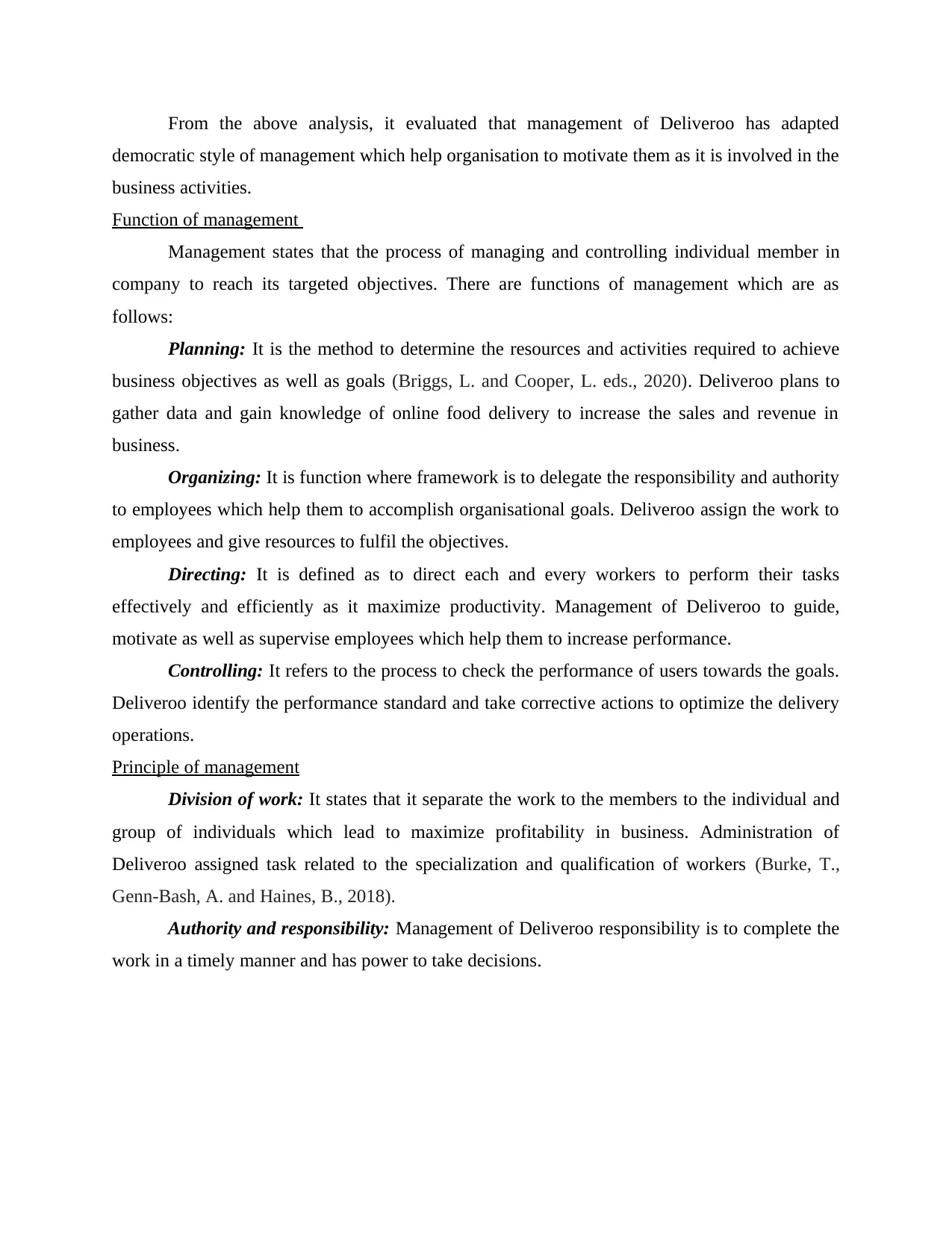
From the above analysis, it evaluated that management of Deliveroo has adapted
democratic style of management which help organisation to motivate them as it is involved in the
business activities.
Function of management
Management states that the process of managing and controlling individual member in
company to reach its targeted objectives. There are functions of management which are as
follows:
Planning: It is the method to determine the resources and activities required to achieve
business objectives as well as goals (Briggs, L. and Cooper, L. eds., 2020). Deliveroo plans to
gather data and gain knowledge of online food delivery to increase the sales and revenue in
business.
Organizing: It is function where framework is to delegate the responsibility and authority
to employees which help them to accomplish organisational goals. Deliveroo assign the work to
employees and give resources to fulfil the objectives.
Directing: It is defined as to direct each and every workers to perform their tasks
effectively and efficiently as it maximize productivity. Management of Deliveroo to guide,
motivate as well as supervise employees which help them to increase performance.
Controlling: It refers to the process to check the performance of users towards the goals.
Deliveroo identify the performance standard and take corrective actions to optimize the delivery
operations.
Principle of management
Division of work: It states that it separate the work to the members to the individual and
group of individuals which lead to maximize profitability in business. Administration of
Deliveroo assigned task related to the specialization and qualification of workers (Burke, T.,
Genn-Bash, A. and Haines, B., 2018).
Authority and responsibility: Management of Deliveroo responsibility is to complete the
work in a timely manner and has power to take decisions.
democratic style of management which help organisation to motivate them as it is involved in the
business activities.
Function of management
Management states that the process of managing and controlling individual member in
company to reach its targeted objectives. There are functions of management which are as
follows:
Planning: It is the method to determine the resources and activities required to achieve
business objectives as well as goals (Briggs, L. and Cooper, L. eds., 2020). Deliveroo plans to
gather data and gain knowledge of online food delivery to increase the sales and revenue in
business.
Organizing: It is function where framework is to delegate the responsibility and authority
to employees which help them to accomplish organisational goals. Deliveroo assign the work to
employees and give resources to fulfil the objectives.
Directing: It is defined as to direct each and every workers to perform their tasks
effectively and efficiently as it maximize productivity. Management of Deliveroo to guide,
motivate as well as supervise employees which help them to increase performance.
Controlling: It refers to the process to check the performance of users towards the goals.
Deliveroo identify the performance standard and take corrective actions to optimize the delivery
operations.
Principle of management
Division of work: It states that it separate the work to the members to the individual and
group of individuals which lead to maximize profitability in business. Administration of
Deliveroo assigned task related to the specialization and qualification of workers (Burke, T.,
Genn-Bash, A. and Haines, B., 2018).
Authority and responsibility: Management of Deliveroo responsibility is to complete the
work in a timely manner and has power to take decisions.
Paraphrase This Document
Need a fresh take? Get an instant paraphrase of this document with our AI Paraphraser
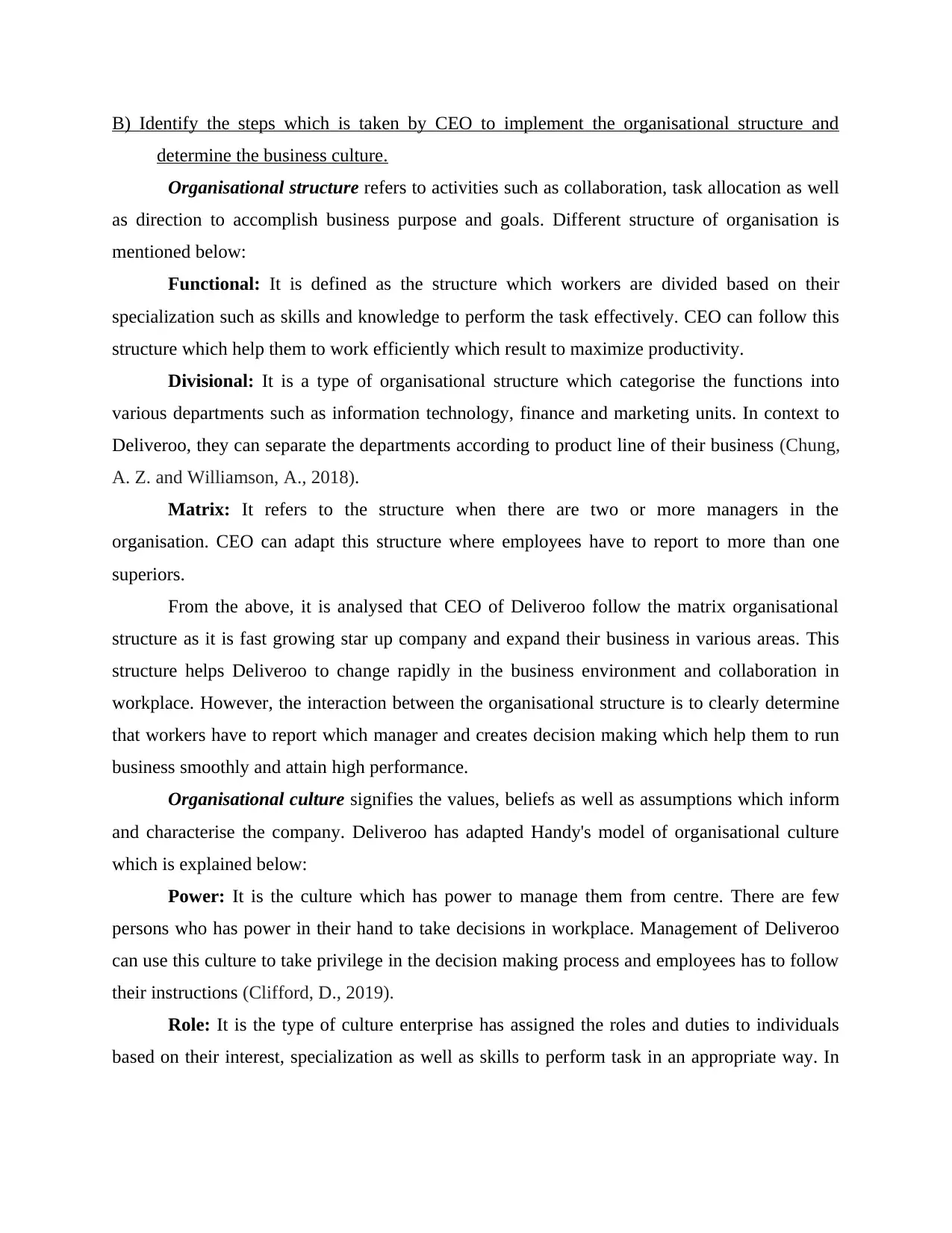
B) Identify the steps which is taken by CEO to implement the organisational structure and
determine the business culture.
Organisational structure refers to activities such as collaboration, task allocation as well
as direction to accomplish business purpose and goals. Different structure of organisation is
mentioned below:
Functional: It is defined as the structure which workers are divided based on their
specialization such as skills and knowledge to perform the task effectively. CEO can follow this
structure which help them to work efficiently which result to maximize productivity.
Divisional: It is a type of organisational structure which categorise the functions into
various departments such as information technology, finance and marketing units. In context to
Deliveroo, they can separate the departments according to product line of their business (Chung,
A. Z. and Williamson, A., 2018).
Matrix: It refers to the structure when there are two or more managers in the
organisation. CEO can adapt this structure where employees have to report to more than one
superiors.
From the above, it is analysed that CEO of Deliveroo follow the matrix organisational
structure as it is fast growing star up company and expand their business in various areas. This
structure helps Deliveroo to change rapidly in the business environment and collaboration in
workplace. However, the interaction between the organisational structure is to clearly determine
that workers have to report which manager and creates decision making which help them to run
business smoothly and attain high performance.
Organisational culture signifies the values, beliefs as well as assumptions which inform
and characterise the company. Deliveroo has adapted Handy's model of organisational culture
which is explained below:
Power: It is the culture which has power to manage them from centre. There are few
persons who has power in their hand to take decisions in workplace. Management of Deliveroo
can use this culture to take privilege in the decision making process and employees has to follow
their instructions (Clifford, D., 2019).
Role: It is the type of culture enterprise has assigned the roles and duties to individuals
based on their interest, specialization as well as skills to perform task in an appropriate way. In
determine the business culture.
Organisational structure refers to activities such as collaboration, task allocation as well
as direction to accomplish business purpose and goals. Different structure of organisation is
mentioned below:
Functional: It is defined as the structure which workers are divided based on their
specialization such as skills and knowledge to perform the task effectively. CEO can follow this
structure which help them to work efficiently which result to maximize productivity.
Divisional: It is a type of organisational structure which categorise the functions into
various departments such as information technology, finance and marketing units. In context to
Deliveroo, they can separate the departments according to product line of their business (Chung,
A. Z. and Williamson, A., 2018).
Matrix: It refers to the structure when there are two or more managers in the
organisation. CEO can adapt this structure where employees have to report to more than one
superiors.
From the above, it is analysed that CEO of Deliveroo follow the matrix organisational
structure as it is fast growing star up company and expand their business in various areas. This
structure helps Deliveroo to change rapidly in the business environment and collaboration in
workplace. However, the interaction between the organisational structure is to clearly determine
that workers have to report which manager and creates decision making which help them to run
business smoothly and attain high performance.
Organisational culture signifies the values, beliefs as well as assumptions which inform
and characterise the company. Deliveroo has adapted Handy's model of organisational culture
which is explained below:
Power: It is the culture which has power to manage them from centre. There are few
persons who has power in their hand to take decisions in workplace. Management of Deliveroo
can use this culture to take privilege in the decision making process and employees has to follow
their instructions (Clifford, D., 2019).
Role: It is the type of culture enterprise has assigned the roles and duties to individuals
based on their interest, specialization as well as skills to perform task in an appropriate way. In
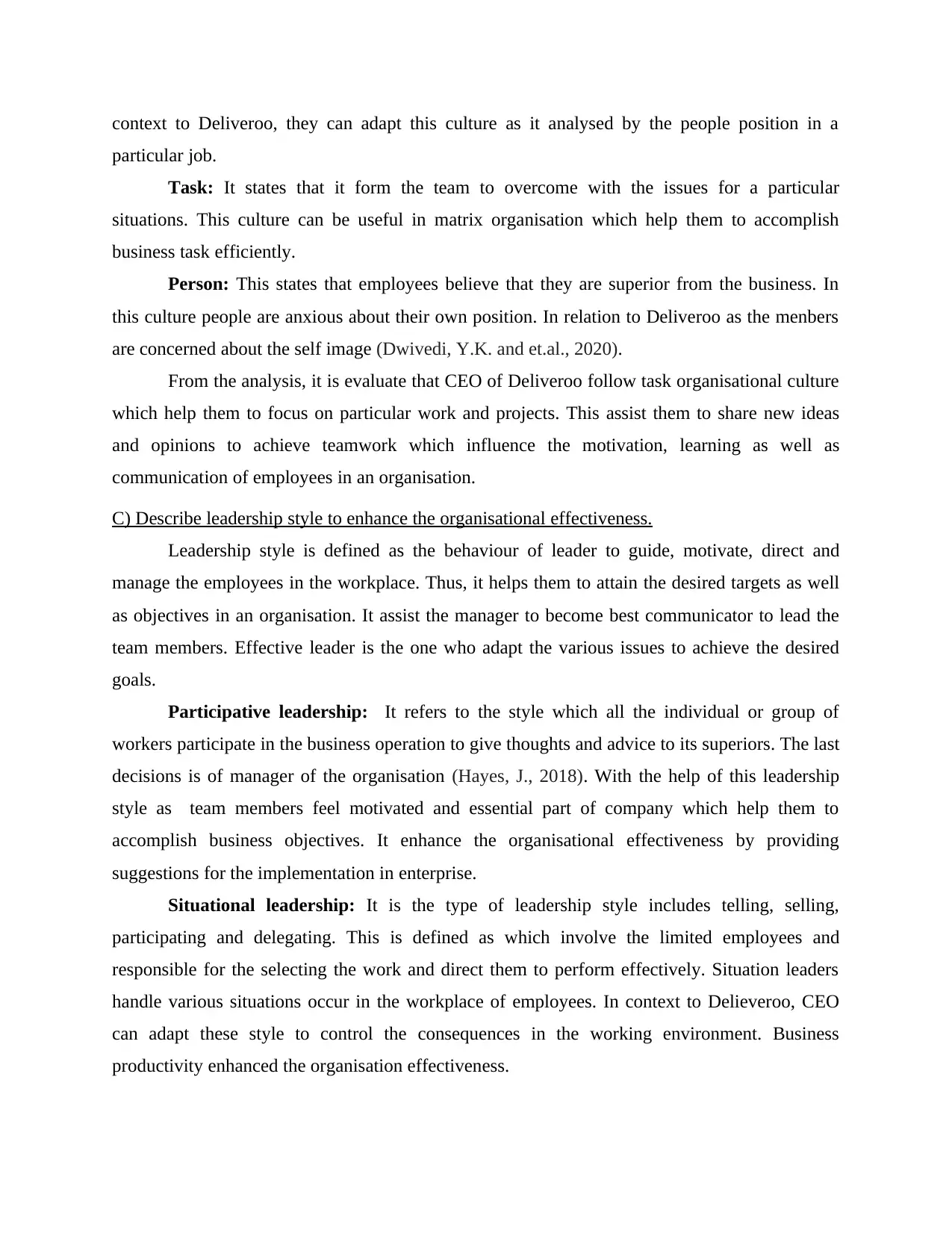
context to Deliveroo, they can adapt this culture as it analysed by the people position in a
particular job.
Task: It states that it form the team to overcome with the issues for a particular
situations. This culture can be useful in matrix organisation which help them to accomplish
business task efficiently.
Person: This states that employees believe that they are superior from the business. In
this culture people are anxious about their own position. In relation to Deliveroo as the menbers
are concerned about the self image (Dwivedi, Y.K. and et.al., 2020).
From the analysis, it is evaluate that CEO of Deliveroo follow task organisational culture
which help them to focus on particular work and projects. This assist them to share new ideas
and opinions to achieve teamwork which influence the motivation, learning as well as
communication of employees in an organisation.
C) Describe leadership style to enhance the organisational effectiveness.
Leadership style is defined as the behaviour of leader to guide, motivate, direct and
manage the employees in the workplace. Thus, it helps them to attain the desired targets as well
as objectives in an organisation. It assist the manager to become best communicator to lead the
team members. Effective leader is the one who adapt the various issues to achieve the desired
goals.
Participative leadership: It refers to the style which all the individual or group of
workers participate in the business operation to give thoughts and advice to its superiors. The last
decisions is of manager of the organisation (Hayes, J., 2018). With the help of this leadership
style as team members feel motivated and essential part of company which help them to
accomplish business objectives. It enhance the organisational effectiveness by providing
suggestions for the implementation in enterprise.
Situational leadership: It is the type of leadership style includes telling, selling,
participating and delegating. This is defined as which involve the limited employees and
responsible for the selecting the work and direct them to perform effectively. Situation leaders
handle various situations occur in the workplace of employees. In context to Delieveroo, CEO
can adapt these style to control the consequences in the working environment. Business
productivity enhanced the organisation effectiveness.
particular job.
Task: It states that it form the team to overcome with the issues for a particular
situations. This culture can be useful in matrix organisation which help them to accomplish
business task efficiently.
Person: This states that employees believe that they are superior from the business. In
this culture people are anxious about their own position. In relation to Deliveroo as the menbers
are concerned about the self image (Dwivedi, Y.K. and et.al., 2020).
From the analysis, it is evaluate that CEO of Deliveroo follow task organisational culture
which help them to focus on particular work and projects. This assist them to share new ideas
and opinions to achieve teamwork which influence the motivation, learning as well as
communication of employees in an organisation.
C) Describe leadership style to enhance the organisational effectiveness.
Leadership style is defined as the behaviour of leader to guide, motivate, direct and
manage the employees in the workplace. Thus, it helps them to attain the desired targets as well
as objectives in an organisation. It assist the manager to become best communicator to lead the
team members. Effective leader is the one who adapt the various issues to achieve the desired
goals.
Participative leadership: It refers to the style which all the individual or group of
workers participate in the business operation to give thoughts and advice to its superiors. The last
decisions is of manager of the organisation (Hayes, J., 2018). With the help of this leadership
style as team members feel motivated and essential part of company which help them to
accomplish business objectives. It enhance the organisational effectiveness by providing
suggestions for the implementation in enterprise.
Situational leadership: It is the type of leadership style includes telling, selling,
participating and delegating. This is defined as which involve the limited employees and
responsible for the selecting the work and direct them to perform effectively. Situation leaders
handle various situations occur in the workplace of employees. In context to Delieveroo, CEO
can adapt these style to control the consequences in the working environment. Business
productivity enhanced the organisation effectiveness.
⊘ This is a preview!⊘
Do you want full access?
Subscribe today to unlock all pages.

Trusted by 1+ million students worldwide
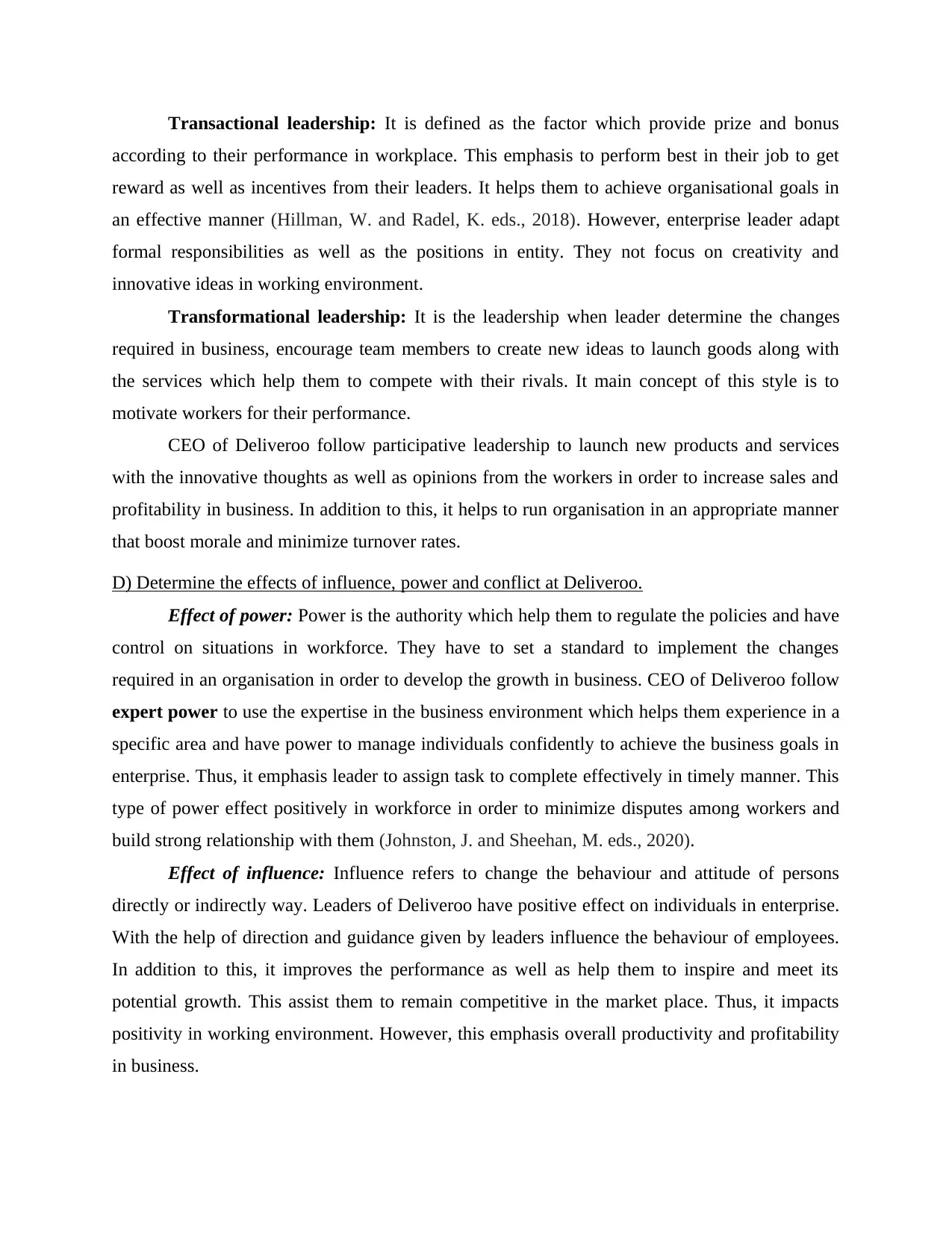
Transactional leadership: It is defined as the factor which provide prize and bonus
according to their performance in workplace. This emphasis to perform best in their job to get
reward as well as incentives from their leaders. It helps them to achieve organisational goals in
an effective manner (Hillman, W. and Radel, K. eds., 2018). However, enterprise leader adapt
formal responsibilities as well as the positions in entity. They not focus on creativity and
innovative ideas in working environment.
Transformational leadership: It is the leadership when leader determine the changes
required in business, encourage team members to create new ideas to launch goods along with
the services which help them to compete with their rivals. It main concept of this style is to
motivate workers for their performance.
CEO of Deliveroo follow participative leadership to launch new products and services
with the innovative thoughts as well as opinions from the workers in order to increase sales and
profitability in business. In addition to this, it helps to run organisation in an appropriate manner
that boost morale and minimize turnover rates.
D) Determine the effects of influence, power and conflict at Deliveroo.
Effect of power: Power is the authority which help them to regulate the policies and have
control on situations in workforce. They have to set a standard to implement the changes
required in an organisation in order to develop the growth in business. CEO of Deliveroo follow
expert power to use the expertise in the business environment which helps them experience in a
specific area and have power to manage individuals confidently to achieve the business goals in
enterprise. Thus, it emphasis leader to assign task to complete effectively in timely manner. This
type of power effect positively in workforce in order to minimize disputes among workers and
build strong relationship with them (Johnston, J. and Sheehan, M. eds., 2020).
Effect of influence: Influence refers to change the behaviour and attitude of persons
directly or indirectly way. Leaders of Deliveroo have positive effect on individuals in enterprise.
With the help of direction and guidance given by leaders influence the behaviour of employees.
In addition to this, it improves the performance as well as help them to inspire and meet its
potential growth. This assist them to remain competitive in the market place. Thus, it impacts
positivity in working environment. However, this emphasis overall productivity and profitability
in business.
according to their performance in workplace. This emphasis to perform best in their job to get
reward as well as incentives from their leaders. It helps them to achieve organisational goals in
an effective manner (Hillman, W. and Radel, K. eds., 2018). However, enterprise leader adapt
formal responsibilities as well as the positions in entity. They not focus on creativity and
innovative ideas in working environment.
Transformational leadership: It is the leadership when leader determine the changes
required in business, encourage team members to create new ideas to launch goods along with
the services which help them to compete with their rivals. It main concept of this style is to
motivate workers for their performance.
CEO of Deliveroo follow participative leadership to launch new products and services
with the innovative thoughts as well as opinions from the workers in order to increase sales and
profitability in business. In addition to this, it helps to run organisation in an appropriate manner
that boost morale and minimize turnover rates.
D) Determine the effects of influence, power and conflict at Deliveroo.
Effect of power: Power is the authority which help them to regulate the policies and have
control on situations in workforce. They have to set a standard to implement the changes
required in an organisation in order to develop the growth in business. CEO of Deliveroo follow
expert power to use the expertise in the business environment which helps them experience in a
specific area and have power to manage individuals confidently to achieve the business goals in
enterprise. Thus, it emphasis leader to assign task to complete effectively in timely manner. This
type of power effect positively in workforce in order to minimize disputes among workers and
build strong relationship with them (Johnston, J. and Sheehan, M. eds., 2020).
Effect of influence: Influence refers to change the behaviour and attitude of persons
directly or indirectly way. Leaders of Deliveroo have positive effect on individuals in enterprise.
With the help of direction and guidance given by leaders influence the behaviour of employees.
In addition to this, it improves the performance as well as help them to inspire and meet its
potential growth. This assist them to remain competitive in the market place. Thus, it impacts
positivity in working environment. However, this emphasis overall productivity and profitability
in business.
Paraphrase This Document
Need a fresh take? Get an instant paraphrase of this document with our AI Paraphraser
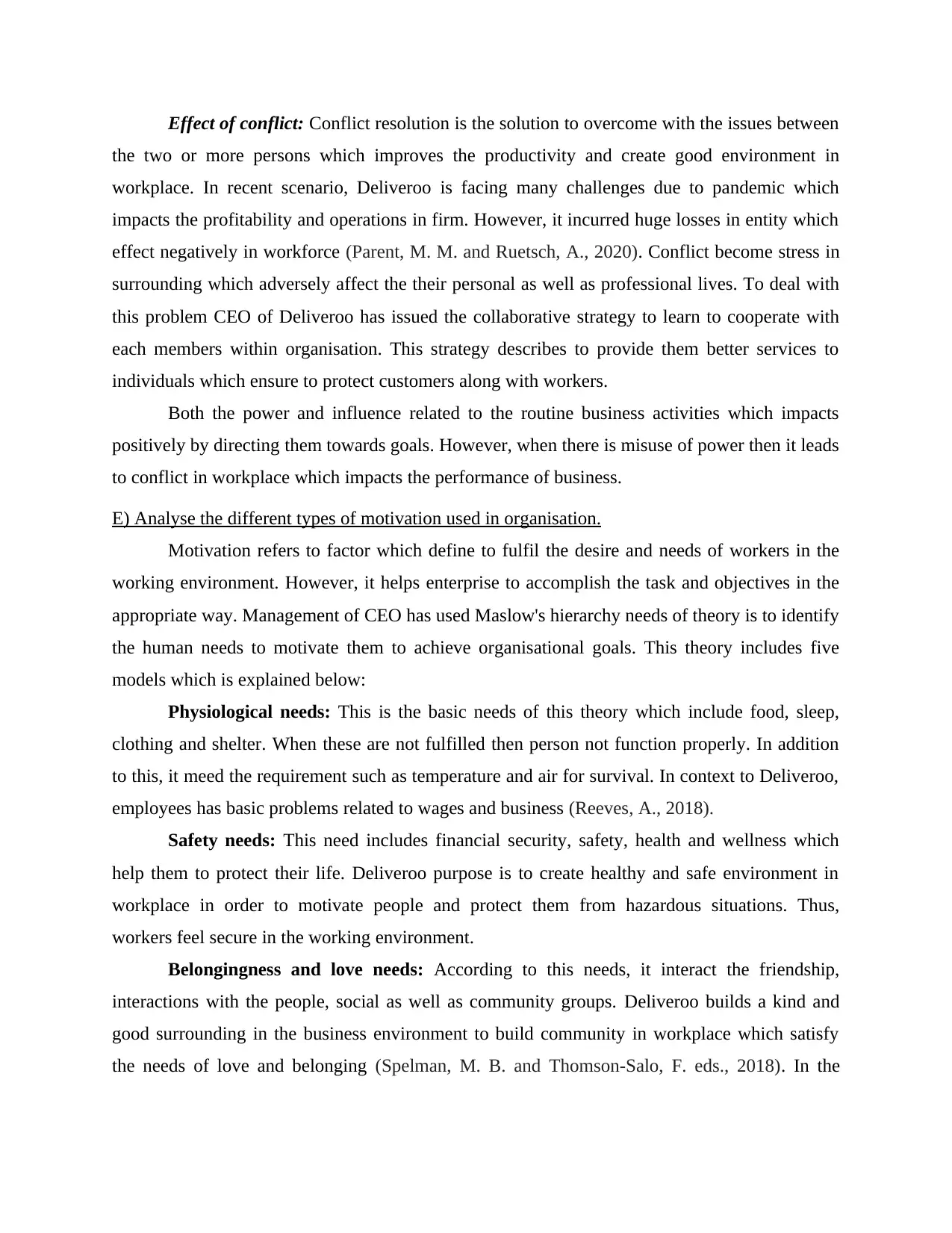
Effect of conflict: Conflict resolution is the solution to overcome with the issues between
the two or more persons which improves the productivity and create good environment in
workplace. In recent scenario, Deliveroo is facing many challenges due to pandemic which
impacts the profitability and operations in firm. However, it incurred huge losses in entity which
effect negatively in workforce (Parent, M. M. and Ruetsch, A., 2020). Conflict become stress in
surrounding which adversely affect the their personal as well as professional lives. To deal with
this problem CEO of Deliveroo has issued the collaborative strategy to learn to cooperate with
each members within organisation. This strategy describes to provide them better services to
individuals which ensure to protect customers along with workers.
Both the power and influence related to the routine business activities which impacts
positively by directing them towards goals. However, when there is misuse of power then it leads
to conflict in workplace which impacts the performance of business.
E) Analyse the different types of motivation used in organisation.
Motivation refers to factor which define to fulfil the desire and needs of workers in the
working environment. However, it helps enterprise to accomplish the task and objectives in the
appropriate way. Management of CEO has used Maslow's hierarchy needs of theory is to identify
the human needs to motivate them to achieve organisational goals. This theory includes five
models which is explained below:
Physiological needs: This is the basic needs of this theory which include food, sleep,
clothing and shelter. When these are not fulfilled then person not function properly. In addition
to this, it meed the requirement such as temperature and air for survival. In context to Deliveroo,
employees has basic problems related to wages and business (Reeves, A., 2018).
Safety needs: This need includes financial security, safety, health and wellness which
help them to protect their life. Deliveroo purpose is to create healthy and safe environment in
workplace in order to motivate people and protect them from hazardous situations. Thus,
workers feel secure in the working environment.
Belongingness and love needs: According to this needs, it interact the friendship,
interactions with the people, social as well as community groups. Deliveroo builds a kind and
good surrounding in the business environment to build community in workplace which satisfy
the needs of love and belonging (Spelman, M. B. and Thomson-Salo, F. eds., 2018). In the
the two or more persons which improves the productivity and create good environment in
workplace. In recent scenario, Deliveroo is facing many challenges due to pandemic which
impacts the profitability and operations in firm. However, it incurred huge losses in entity which
effect negatively in workforce (Parent, M. M. and Ruetsch, A., 2020). Conflict become stress in
surrounding which adversely affect the their personal as well as professional lives. To deal with
this problem CEO of Deliveroo has issued the collaborative strategy to learn to cooperate with
each members within organisation. This strategy describes to provide them better services to
individuals which ensure to protect customers along with workers.
Both the power and influence related to the routine business activities which impacts
positively by directing them towards goals. However, when there is misuse of power then it leads
to conflict in workplace which impacts the performance of business.
E) Analyse the different types of motivation used in organisation.
Motivation refers to factor which define to fulfil the desire and needs of workers in the
working environment. However, it helps enterprise to accomplish the task and objectives in the
appropriate way. Management of CEO has used Maslow's hierarchy needs of theory is to identify
the human needs to motivate them to achieve organisational goals. This theory includes five
models which is explained below:
Physiological needs: This is the basic needs of this theory which include food, sleep,
clothing and shelter. When these are not fulfilled then person not function properly. In addition
to this, it meed the requirement such as temperature and air for survival. In context to Deliveroo,
employees has basic problems related to wages and business (Reeves, A., 2018).
Safety needs: This need includes financial security, safety, health and wellness which
help them to protect their life. Deliveroo purpose is to create healthy and safe environment in
workplace in order to motivate people and protect them from hazardous situations. Thus,
workers feel secure in the working environment.
Belongingness and love needs: According to this needs, it interact the friendship,
interactions with the people, social as well as community groups. Deliveroo builds a kind and
good surrounding in the business environment to build community in workplace which satisfy
the needs of love and belonging (Spelman, M. B. and Thomson-Salo, F. eds., 2018). In the
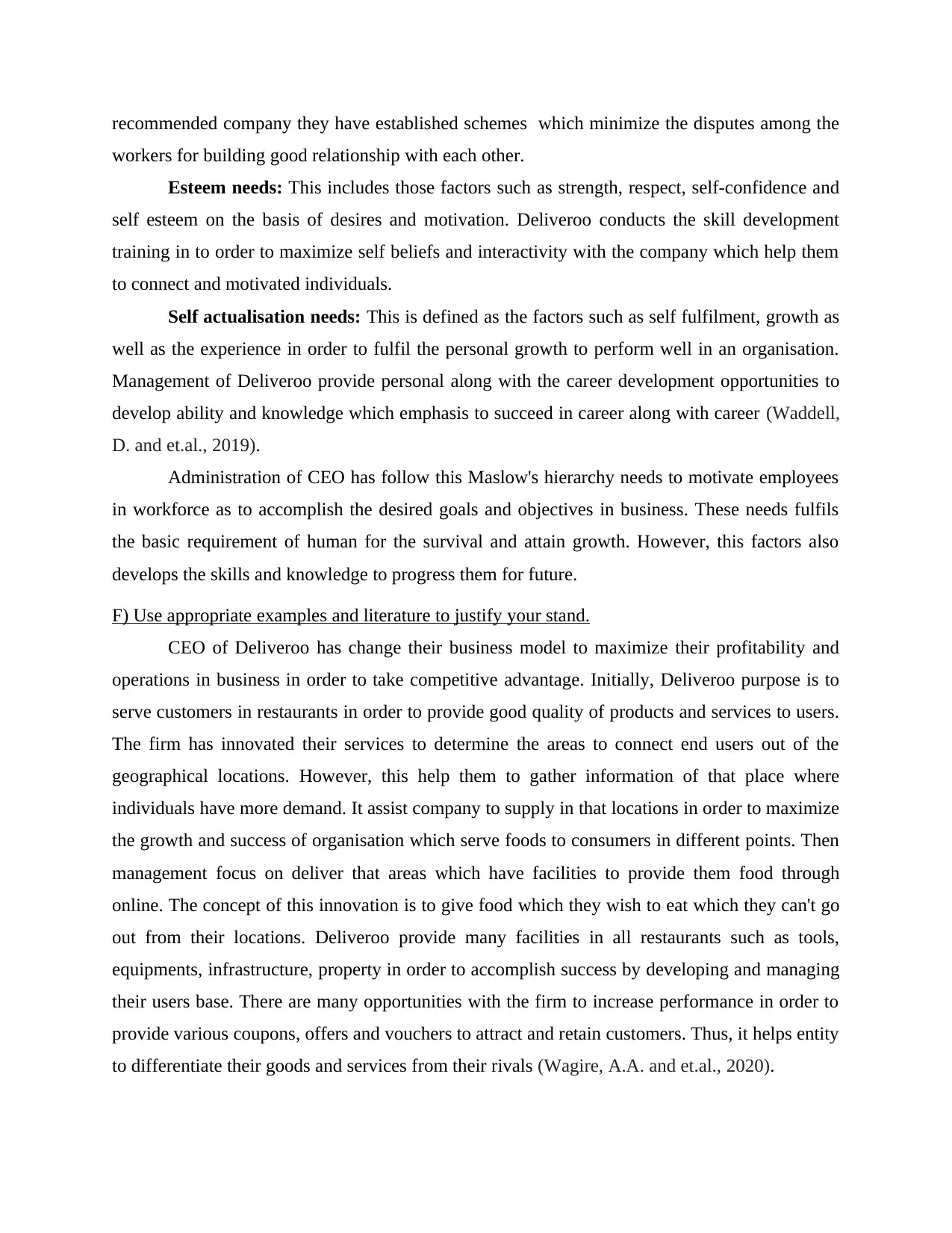
recommended company they have established schemes which minimize the disputes among the
workers for building good relationship with each other.
Esteem needs: This includes those factors such as strength, respect, self-confidence and
self esteem on the basis of desires and motivation. Deliveroo conducts the skill development
training in to order to maximize self beliefs and interactivity with the company which help them
to connect and motivated individuals.
Self actualisation needs: This is defined as the factors such as self fulfilment, growth as
well as the experience in order to fulfil the personal growth to perform well in an organisation.
Management of Deliveroo provide personal along with the career development opportunities to
develop ability and knowledge which emphasis to succeed in career along with career (Waddell,
D. and et.al., 2019).
Administration of CEO has follow this Maslow's hierarchy needs to motivate employees
in workforce as to accomplish the desired goals and objectives in business. These needs fulfils
the basic requirement of human for the survival and attain growth. However, this factors also
develops the skills and knowledge to progress them for future.
F) Use appropriate examples and literature to justify your stand.
CEO of Deliveroo has change their business model to maximize their profitability and
operations in business in order to take competitive advantage. Initially, Deliveroo purpose is to
serve customers in restaurants in order to provide good quality of products and services to users.
The firm has innovated their services to determine the areas to connect end users out of the
geographical locations. However, this help them to gather information of that place where
individuals have more demand. It assist company to supply in that locations in order to maximize
the growth and success of organisation which serve foods to consumers in different points. Then
management focus on deliver that areas which have facilities to provide them food through
online. The concept of this innovation is to give food which they wish to eat which they can't go
out from their locations. Deliveroo provide many facilities in all restaurants such as tools,
equipments, infrastructure, property in order to accomplish success by developing and managing
their users base. There are many opportunities with the firm to increase performance in order to
provide various coupons, offers and vouchers to attract and retain customers. Thus, it helps entity
to differentiate their goods and services from their rivals (Wagire, A.A. and et.al., 2020).
workers for building good relationship with each other.
Esteem needs: This includes those factors such as strength, respect, self-confidence and
self esteem on the basis of desires and motivation. Deliveroo conducts the skill development
training in to order to maximize self beliefs and interactivity with the company which help them
to connect and motivated individuals.
Self actualisation needs: This is defined as the factors such as self fulfilment, growth as
well as the experience in order to fulfil the personal growth to perform well in an organisation.
Management of Deliveroo provide personal along with the career development opportunities to
develop ability and knowledge which emphasis to succeed in career along with career (Waddell,
D. and et.al., 2019).
Administration of CEO has follow this Maslow's hierarchy needs to motivate employees
in workforce as to accomplish the desired goals and objectives in business. These needs fulfils
the basic requirement of human for the survival and attain growth. However, this factors also
develops the skills and knowledge to progress them for future.
F) Use appropriate examples and literature to justify your stand.
CEO of Deliveroo has change their business model to maximize their profitability and
operations in business in order to take competitive advantage. Initially, Deliveroo purpose is to
serve customers in restaurants in order to provide good quality of products and services to users.
The firm has innovated their services to determine the areas to connect end users out of the
geographical locations. However, this help them to gather information of that place where
individuals have more demand. It assist company to supply in that locations in order to maximize
the growth and success of organisation which serve foods to consumers in different points. Then
management focus on deliver that areas which have facilities to provide them food through
online. The concept of this innovation is to give food which they wish to eat which they can't go
out from their locations. Deliveroo provide many facilities in all restaurants such as tools,
equipments, infrastructure, property in order to accomplish success by developing and managing
their users base. There are many opportunities with the firm to increase performance in order to
provide various coupons, offers and vouchers to attract and retain customers. Thus, it helps entity
to differentiate their goods and services from their rivals (Wagire, A.A. and et.al., 2020).
⊘ This is a preview!⊘
Do you want full access?
Subscribe today to unlock all pages.

Trusted by 1+ million students worldwide
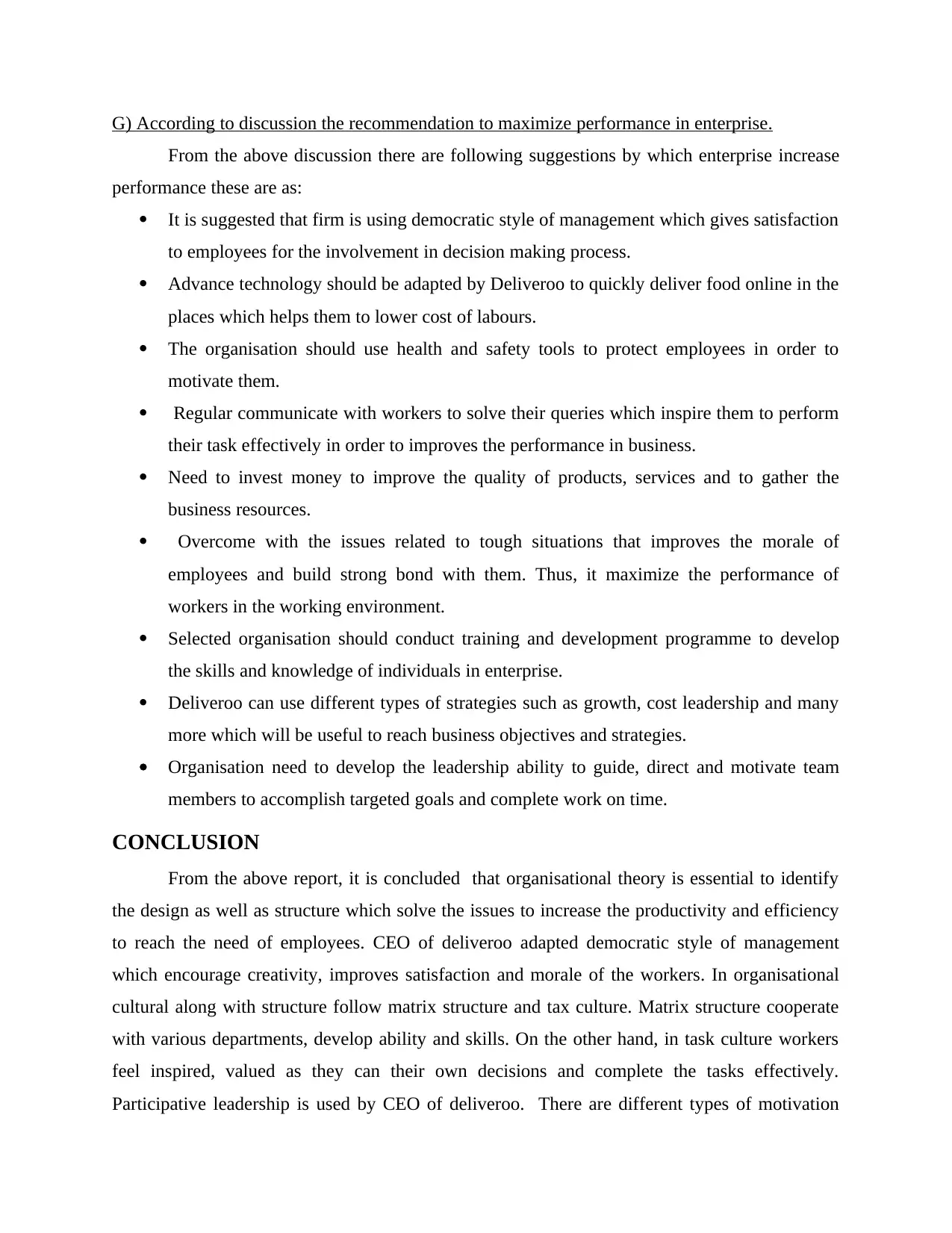
G) According to discussion the recommendation to maximize performance in enterprise.
From the above discussion there are following suggestions by which enterprise increase
performance these are as:
It is suggested that firm is using democratic style of management which gives satisfaction
to employees for the involvement in decision making process.
Advance technology should be adapted by Deliveroo to quickly deliver food online in the
places which helps them to lower cost of labours.
The organisation should use health and safety tools to protect employees in order to
motivate them.
Regular communicate with workers to solve their queries which inspire them to perform
their task effectively in order to improves the performance in business.
Need to invest money to improve the quality of products, services and to gather the
business resources.
Overcome with the issues related to tough situations that improves the morale of
employees and build strong bond with them. Thus, it maximize the performance of
workers in the working environment.
Selected organisation should conduct training and development programme to develop
the skills and knowledge of individuals in enterprise.
Deliveroo can use different types of strategies such as growth, cost leadership and many
more which will be useful to reach business objectives and strategies.
Organisation need to develop the leadership ability to guide, direct and motivate team
members to accomplish targeted goals and complete work on time.
CONCLUSION
From the above report, it is concluded that organisational theory is essential to identify
the design as well as structure which solve the issues to increase the productivity and efficiency
to reach the need of employees. CEO of deliveroo adapted democratic style of management
which encourage creativity, improves satisfaction and morale of the workers. In organisational
cultural along with structure follow matrix structure and tax culture. Matrix structure cooperate
with various departments, develop ability and skills. On the other hand, in task culture workers
feel inspired, valued as they can their own decisions and complete the tasks effectively.
Participative leadership is used by CEO of deliveroo. There are different types of motivation
From the above discussion there are following suggestions by which enterprise increase
performance these are as:
It is suggested that firm is using democratic style of management which gives satisfaction
to employees for the involvement in decision making process.
Advance technology should be adapted by Deliveroo to quickly deliver food online in the
places which helps them to lower cost of labours.
The organisation should use health and safety tools to protect employees in order to
motivate them.
Regular communicate with workers to solve their queries which inspire them to perform
their task effectively in order to improves the performance in business.
Need to invest money to improve the quality of products, services and to gather the
business resources.
Overcome with the issues related to tough situations that improves the morale of
employees and build strong bond with them. Thus, it maximize the performance of
workers in the working environment.
Selected organisation should conduct training and development programme to develop
the skills and knowledge of individuals in enterprise.
Deliveroo can use different types of strategies such as growth, cost leadership and many
more which will be useful to reach business objectives and strategies.
Organisation need to develop the leadership ability to guide, direct and motivate team
members to accomplish targeted goals and complete work on time.
CONCLUSION
From the above report, it is concluded that organisational theory is essential to identify
the design as well as structure which solve the issues to increase the productivity and efficiency
to reach the need of employees. CEO of deliveroo adapted democratic style of management
which encourage creativity, improves satisfaction and morale of the workers. In organisational
cultural along with structure follow matrix structure and tax culture. Matrix structure cooperate
with various departments, develop ability and skills. On the other hand, in task culture workers
feel inspired, valued as they can their own decisions and complete the tasks effectively.
Participative leadership is used by CEO of deliveroo. There are different types of motivation
Paraphrase This Document
Need a fresh take? Get an instant paraphrase of this document with our AI Paraphraser
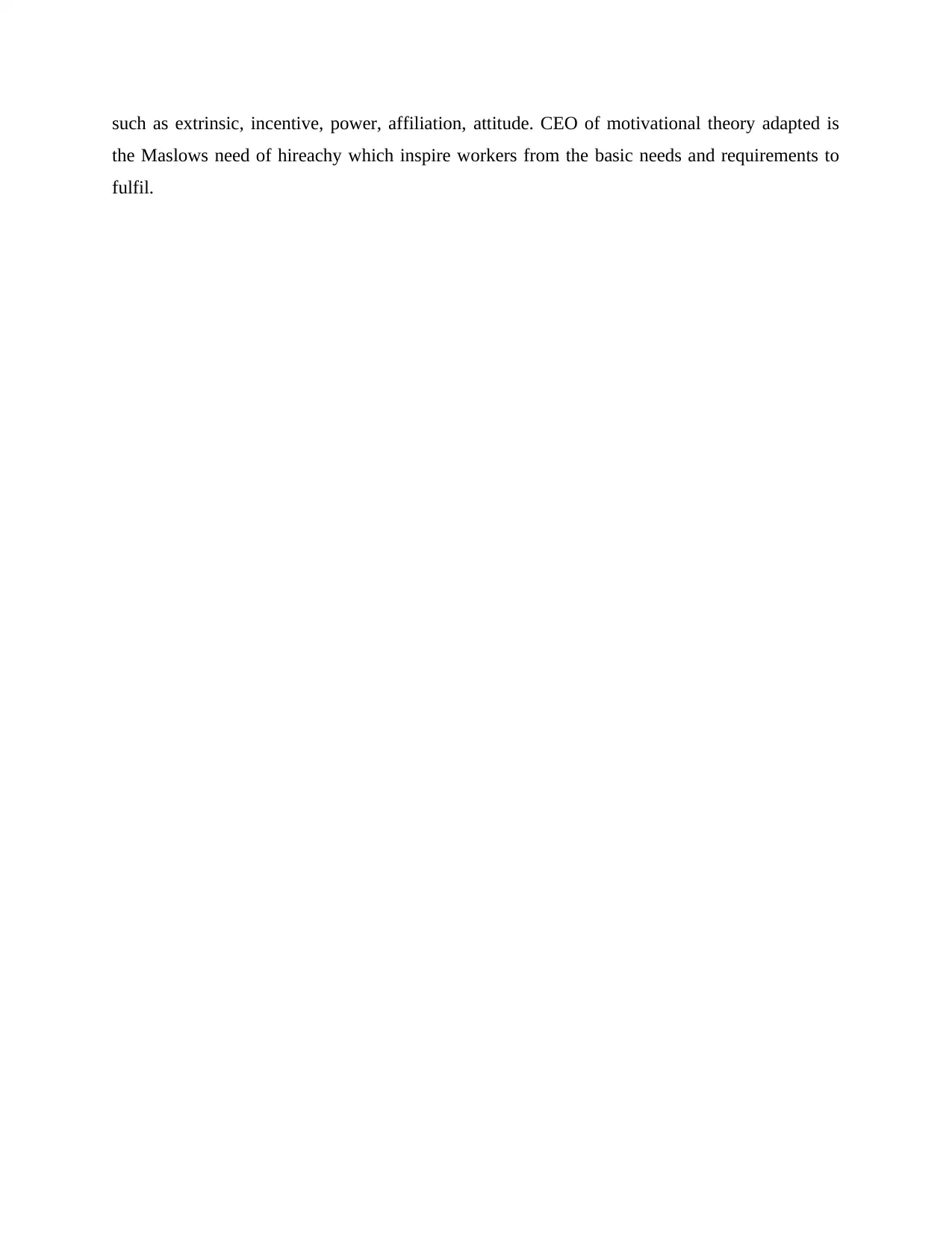
such as extrinsic, incentive, power, affiliation, attitude. CEO of motivational theory adapted is
the Maslows need of hireachy which inspire workers from the basic needs and requirements to
fulfil.
the Maslows need of hireachy which inspire workers from the basic needs and requirements to
fulfil.
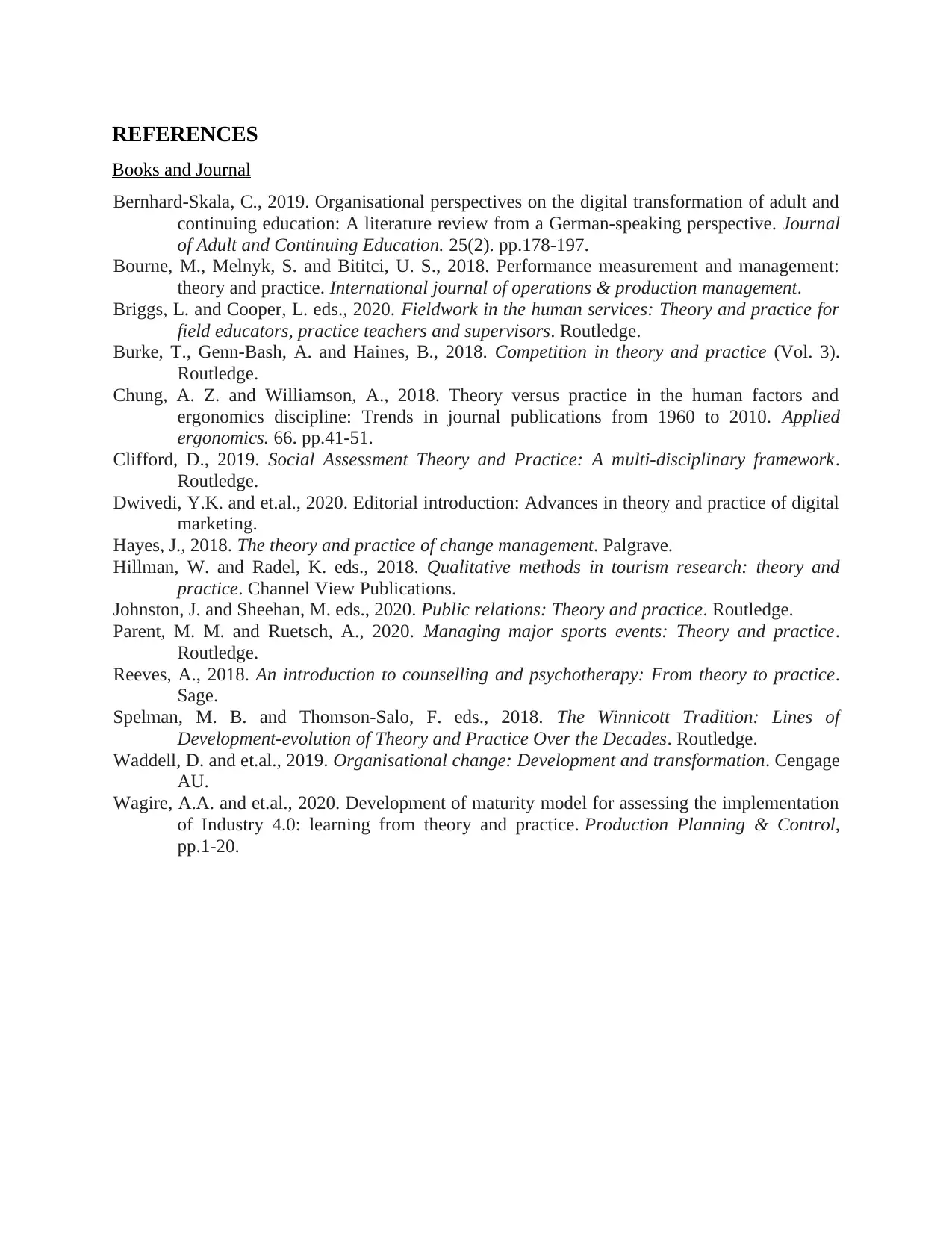
REFERENCES
Books and Journal
Bernhard-Skala, C., 2019. Organisational perspectives on the digital transformation of adult and
continuing education: A literature review from a German-speaking perspective. Journal
of Adult and Continuing Education. 25(2). pp.178-197.
Bourne, M., Melnyk, S. and Bititci, U. S., 2018. Performance measurement and management:
theory and practice. International journal of operations & production management.
Briggs, L. and Cooper, L. eds., 2020. Fieldwork in the human services: Theory and practice for
field educators, practice teachers and supervisors. Routledge.
Burke, T., Genn-Bash, A. and Haines, B., 2018. Competition in theory and practice (Vol. 3).
Routledge.
Chung, A. Z. and Williamson, A., 2018. Theory versus practice in the human factors and
ergonomics discipline: Trends in journal publications from 1960 to 2010. Applied
ergonomics. 66. pp.41-51.
Clifford, D., 2019. Social Assessment Theory and Practice: A multi-disciplinary framework.
Routledge.
Dwivedi, Y.K. and et.al., 2020. Editorial introduction: Advances in theory and practice of digital
marketing.
Hayes, J., 2018. The theory and practice of change management. Palgrave.
Hillman, W. and Radel, K. eds., 2018. Qualitative methods in tourism research: theory and
practice. Channel View Publications.
Johnston, J. and Sheehan, M. eds., 2020. Public relations: Theory and practice. Routledge.
Parent, M. M. and Ruetsch, A., 2020. Managing major sports events: Theory and practice.
Routledge.
Reeves, A., 2018. An introduction to counselling and psychotherapy: From theory to practice.
Sage.
Spelman, M. B. and Thomson-Salo, F. eds., 2018. The Winnicott Tradition: Lines of
Development-evolution of Theory and Practice Over the Decades. Routledge.
Waddell, D. and et.al., 2019. Organisational change: Development and transformation. Cengage
AU.
Wagire, A.A. and et.al., 2020. Development of maturity model for assessing the implementation
of Industry 4.0: learning from theory and practice. Production Planning & Control,
pp.1-20.
Books and Journal
Bernhard-Skala, C., 2019. Organisational perspectives on the digital transformation of adult and
continuing education: A literature review from a German-speaking perspective. Journal
of Adult and Continuing Education. 25(2). pp.178-197.
Bourne, M., Melnyk, S. and Bititci, U. S., 2018. Performance measurement and management:
theory and practice. International journal of operations & production management.
Briggs, L. and Cooper, L. eds., 2020. Fieldwork in the human services: Theory and practice for
field educators, practice teachers and supervisors. Routledge.
Burke, T., Genn-Bash, A. and Haines, B., 2018. Competition in theory and practice (Vol. 3).
Routledge.
Chung, A. Z. and Williamson, A., 2018. Theory versus practice in the human factors and
ergonomics discipline: Trends in journal publications from 1960 to 2010. Applied
ergonomics. 66. pp.41-51.
Clifford, D., 2019. Social Assessment Theory and Practice: A multi-disciplinary framework.
Routledge.
Dwivedi, Y.K. and et.al., 2020. Editorial introduction: Advances in theory and practice of digital
marketing.
Hayes, J., 2018. The theory and practice of change management. Palgrave.
Hillman, W. and Radel, K. eds., 2018. Qualitative methods in tourism research: theory and
practice. Channel View Publications.
Johnston, J. and Sheehan, M. eds., 2020. Public relations: Theory and practice. Routledge.
Parent, M. M. and Ruetsch, A., 2020. Managing major sports events: Theory and practice.
Routledge.
Reeves, A., 2018. An introduction to counselling and psychotherapy: From theory to practice.
Sage.
Spelman, M. B. and Thomson-Salo, F. eds., 2018. The Winnicott Tradition: Lines of
Development-evolution of Theory and Practice Over the Decades. Routledge.
Waddell, D. and et.al., 2019. Organisational change: Development and transformation. Cengage
AU.
Wagire, A.A. and et.al., 2020. Development of maturity model for assessing the implementation
of Industry 4.0: learning from theory and practice. Production Planning & Control,
pp.1-20.
⊘ This is a preview!⊘
Do you want full access?
Subscribe today to unlock all pages.

Trusted by 1+ million students worldwide
1 out of 12
Related Documents
Your All-in-One AI-Powered Toolkit for Academic Success.
+13062052269
info@desklib.com
Available 24*7 on WhatsApp / Email
![[object Object]](/_next/static/media/star-bottom.7253800d.svg)
Unlock your academic potential
Copyright © 2020–2025 A2Z Services. All Rights Reserved. Developed and managed by ZUCOL.





